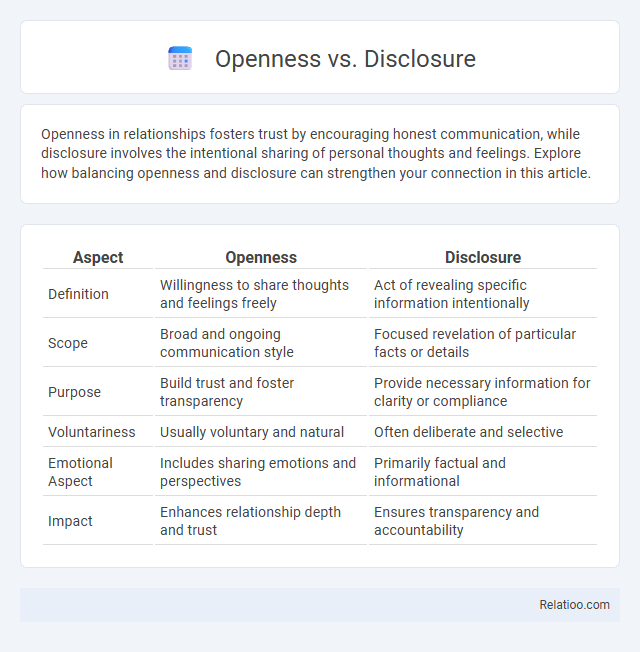Openness in relationships fosters trust by encouraging honest communication, while disclosure involves the intentional sharing of personal thoughts and feelings. Explore how balancing openness and disclosure can strengthen your connection in this article.
Table of Comparison
| Aspect | Openness | Disclosure |
|---|---|---|
| Definition | Willingness to share thoughts and feelings freely | Act of revealing specific information intentionally |
| Scope | Broad and ongoing communication style | Focused revelation of particular facts or details |
| Purpose | Build trust and foster transparency | Provide necessary information for clarity or compliance |
| Voluntariness | Usually voluntary and natural | Often deliberate and selective |
| Emotional Aspect | Includes sharing emotions and perspectives | Primarily factual and informational |
| Impact | Enhances relationship depth and trust | Ensures transparency and accountability |
Understanding Openness and Disclosure
Understanding openness involves embracing transparency and receptiveness to new ideas, fostering trust in personal and professional relationships. Disclosure specifically refers to the act of revealing information, which may be selective or complete, depending on context and intent. Differentiating openness from disclosure highlights that openness is a broader attitude towards sharing and receiving information, while disclosure is the measurable action of providing specific details.
Defining Openness in Communication
Openness in communication refers to the willingness to share thoughts, feelings, and information honestly and transparently without withholding critical details. Unlike disclosure, which involves selectively revealing specific information, openness implies a broader, more continuous exchange that fosters trust and mutual understanding. This concept highlights an environment where individuals feel safe to express themselves fully, facilitating deeper relational connections and effective collaboration.
What Does Disclosure Mean?
Disclosure means revealing specific information or facts that were previously hidden or unknown, often in a formal or mandatory context. Unlike general openness, which implies a broad willingness to share thoughts or feelings, disclosure targets particular data or details relevant to a situation, such as financial records, personal history, or legal matters. Understanding what disclosure means helps you navigate when and how to share essential information ethically and transparently.
Key Differences Between Openness and Disclosure
Openness involves a general willingness to share thoughts, feelings, and information, fostering trust and transparency, whereas disclosure refers specifically to the act of revealing particular facts or sensitive information. Openness is broader and ongoing, characterized by a consistent attitude, while disclosure is often situational, intentional, and selective. Understanding key differences helps to effectively manage communication dynamics in personal and professional contexts.
The Importance of Openness in Relationships
Openness fosters trust and emotional intimacy by encouraging honest communication and vulnerability between partners. Unlike mere disclosure, which involves sharing specific information, true openness creates a safe space for Your thoughts and feelings to be expressed without fear of judgment. This essential quality strengthens bonds and promotes mutual understanding, enhancing the overall quality of relationships.
When is Disclosure Necessary?
Disclosure becomes necessary when sharing specific, sensitive information impacts trust, legal obligations, or ethical responsibilities. Openness involves a general willingness to share thoughts and feelings, but disclosure requires deliberate communication of details that may affect others' decisions or well-being. Your choice to disclose should balance transparency with privacy, ensuring information shared is relevant and appropriate for the context.
Benefits of Practicing Openness
Practicing openness fosters trust by encouraging transparent communication and the free exchange of ideas, leading to stronger relationships and collaboration in personal and professional environments. Unlike mere disclosure, openness involves a proactive willingness to share thoughts and feelings, which cultivates innovation and mutual understanding by reducing misunderstandings. Embracing openness enhances emotional intelligence and resilience, supporting a culture where feedback is valued and growth is continuous.
Risks and Challenges of Disclosure
Disclosure involves revealing sensitive information, posing significant risks such as data breaches, loss of competitive advantage, and legal liabilities. Unlike general openness, disclosure demands careful assessment of what to share to avoid misinterpretation or misuse of information. Challenges include balancing transparency with confidentiality, maintaining stakeholder trust, and complying with regulatory requirements to mitigate potential negative consequences.
Balancing Openness and Privacy
Balancing openness and privacy involves carefully managing what information you share while protecting sensitive data from exposure. Openness encourages transparency and trust, but excessive disclosure can compromise privacy and security. Your strategy should prioritize selective sharing to maintain a healthy equilibrium between transparency and confidentiality.
Best Practices for Healthy Communication
Openness fosters trust and emotional connection by encouraging honest sharing of thoughts and feelings, while disclosure refers specifically to revealing personal information that influences understanding. Effective communication balances openness with discretion, ensuring Your messages respect boundaries and promote psychological safety. Best practices include active listening, timely feedback, and creating an environment where vulnerability is welcomed but not coerced.

Infographic: Openness vs Disclosure
 relatioo.com
relatioo.com